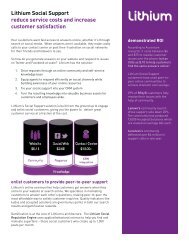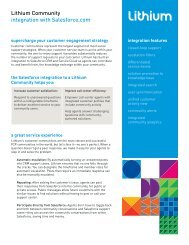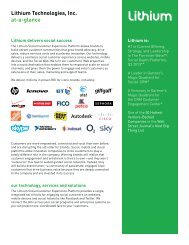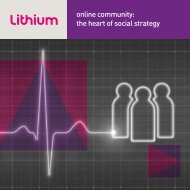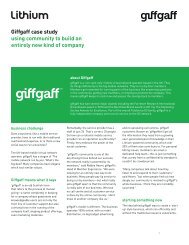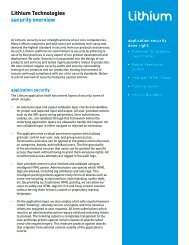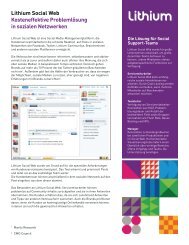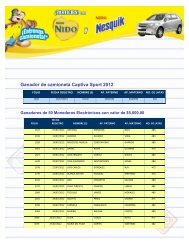what is online community? - Lithium
what is online community? - Lithium
what is online community? - Lithium
You also want an ePaper? Increase the reach of your titles
YUMPU automatically turns print PDFs into web optimized ePapers that Google loves.
superfans: building trust<br />
and commitment through<br />
<strong>online</strong> reputation
contents<br />
1 intro<br />
3 defining health factors for <strong>online</strong> communities<br />
5 after peak Facebook<br />
6 <strong>what</strong> <strong>is</strong> <strong>online</strong> <strong>community</strong>?<br />
8 organizational ownership<br />
10 conclusion<br />
we help companies unlock the passion of their customers.<br />
The <strong>Lithium</strong> Social Customer Suite allows brands to build vibrant customer communities that:<br />
lithium.com | © 2012 <strong>Lithium</strong> Technologies, Inc. All Rights Reserved<br />
share th<strong>is</strong> whitepaper<br />
2
intro<br />
Communities thrive or fail based upon trust. Consumers<br />
must have some degree of trust in the hosting brand to make<br />
the <strong>community</strong> successful, but far more important <strong>is</strong> the trust<br />
that consumers have in their peers.<br />
There are two key benefits to peer-to-peer trust, each<br />
one required for a brand <strong>community</strong> to achieve its<br />
business objectives:<br />
If consumers trust that their peers know <strong>what</strong> they are talking<br />
about, they are more likely to follow their advice, whether that’s<br />
advice about which product to purchase or how to fix a problem<br />
with a product they’ve encountered. The most prolific users<br />
typically create 90% of the content in a brand <strong>community</strong>, so it<br />
<strong>is</strong> vital that v<strong>is</strong>itors know who among them <strong>is</strong> trustworthy.<br />
If new <strong>community</strong> members see that the <strong>community</strong> rewards<br />
engagement with higher levels of status and privilege, they<br />
are more likely to invest their time and effort in making the<br />
<strong>community</strong> successful. In other words, the <strong>community</strong> <strong>is</strong><br />
something like a video game—the drive to move up to the next<br />
level compels members to higher levels of participation.<br />
share th<strong>is</strong> whitepaper<br />
Even a customer <strong>community</strong> with a million members depends<br />
upon a fairly small number of people, typically around 1%, to<br />
generate much of the excitement and interest. Without the<br />
peer trust created by a reputation management system, th<strong>is</strong><br />
1%—the superfans—will not engage and the <strong>community</strong> will<br />
not achieve its business objectives. So it <strong>is</strong> vital to understand<br />
the dynamics of <strong>online</strong> reputation and use the best available<br />
tools for managing it.<br />
Building th<strong>is</strong> web of trust requires both the right technology<br />
and an understanding of human behavior. <strong>Lithium</strong>’s approach<br />
to <strong>online</strong> reputation combines those. Our software and<br />
practices are based upon:<br />
Ten years of social interaction data across several hundred<br />
communities, tens of millions of users, and 50,000<br />
superfans—consumers whose deep engagement with brand<br />
communities drives others to participate.<br />
Research conducted by <strong>Lithium</strong>’s Principal Scient<strong>is</strong>t, Dr.<br />
Michael Wu, who was recently named (along with Marc<br />
Benioff and Mark Zuckerberg) as one of the most influential<br />
people in CRM. <strong>Lithium</strong> encourages Michael to share<br />
h<strong>is</strong> research findings in a blog, which you can find on the<br />
Lithosphere, <strong>Lithium</strong>’s own <strong>community</strong>.<br />
1
Real-world interactions through the communities <strong>Lithium</strong><br />
hosts for its clients, including some of the largest, brandsponsored<br />
communities in the world at HP, AT&T, PlayStation<br />
Europe, and Univ<strong>is</strong>ion. <strong>Lithium</strong>’s customer success managers<br />
(CSMs) are actively engaged with our clients in designing<br />
reputation and reward programs in their communities.<br />
A well-executed reputation system delivers tremendous<br />
return on investment by empowering the smartest, most<br />
committed members of the <strong>community</strong> to take on much<br />
of the responsibility of managing the site and driving its<br />
business objectives. A small minority of superfans makes the<br />
difference between success and failure in brand communities.<br />
For example:<br />
Lenovo’s award-winning customer support site <strong>is</strong> staffed by a<br />
moderation team composed entirely of customer volunteers<br />
from all over the world—US, Australia, Canada, Germany,<br />
India, Pak<strong>is</strong>tan, and Turkey. Initially, the collaboration focused<br />
on the operation of the <strong>community</strong>—the policies, the rules,<br />
and the content. But in just one year, 30 members who had<br />
earned the trust of Lenovo and their peers helped grow<br />
Lenovo’s knowledge base to 1200 articles.<br />
Engl<strong>is</strong>h mobile telephony provider giffgaff’s remarkable<br />
customer <strong>community</strong> <strong>is</strong> both the customer service and<br />
marketing arm of the company, which has fewer than 20<br />
employees! The average time to receive a response in the<br />
giffgaff support forum <strong>is</strong> under three minutes, and 100% of<br />
technical questions are answered by the <strong>community</strong>. Giffgaff<br />
members who answer others’ questions effectively and earn<br />
high status also receive free air-time, which they can then<br />
give as gifts to their friends. Th<strong>is</strong> makes these high-status<br />
users word-of-mouth marketing agents.<br />
share th<strong>is</strong> whitepaper<br />
One user on Logitech’s <strong>community</strong> has posted 45,000 times<br />
since May 2006, an average of almost 25 times per day! These<br />
answers to technical and purchase questions have been<br />
viewed millions of times, giving him an effective reach larger<br />
and more lasting than the company’s advert<strong>is</strong>ing campaigns.<br />
An effective rank and reputation system must<br />
do the following:<br />
Reward members for the full range of socially beneficial<br />
behaviors. Th<strong>is</strong> sounds simple, but many systems do a poor<br />
job of it. For example, simple reputation systems confer<br />
status upon users based purely on the number of posts they<br />
create, but th<strong>is</strong> creates perverse incentives. Members post for<br />
the sake of posting in order to “game the system” rather than<br />
focusing on quality posts. Moreover, some members v<strong>is</strong>it the<br />
<strong>community</strong> every day, but only post when they have something<br />
very important to say. These members may actually be the<br />
glue that holds the <strong>community</strong> together, but many reputation<br />
systems treat them poorly because they don’t post often.<br />
Motivate members continuously through their engagement<br />
process by progressively making succeeding levels of<br />
achievement more difficult to attain. Th<strong>is</strong> concept <strong>is</strong><br />
sometimes known as “game mechanics,” and it <strong>is</strong> critical to<br />
keeping members engaged. Some of <strong>Lithium</strong>’s long-standing<br />
communities have over 150 different levels because members<br />
keep ra<strong>is</strong>ing the standard.<br />
Confer meaningful privileges upon superfans. Many systems<br />
d<strong>is</strong>play v<strong>is</strong>ible badges of status, and th<strong>is</strong> <strong>is</strong> necessary but not<br />
sufficient. While superfans are motivated by public status<br />
markers, long-standing members are motivated by having<br />
authority, such as the ability to move or delete content, the<br />
ability to edit or write blog or knowledgebase articles, the<br />
ability to post comments without moderation, and the ability<br />
to d<strong>is</strong>cipline members of the <strong>community</strong> who cause trouble.<br />
2
defining health<br />
factors for <strong>online</strong><br />
communities<br />
Offer multiple paths to success. A brand <strong>community</strong> <strong>is</strong> a<br />
complex ecosystem. Some people may be experts in one<br />
product but not in another. Some may be great at starting<br />
d<strong>is</strong>cussions, others may be great answerers of questions,<br />
and still others may be friendly and welcoming. The rules<br />
underlying the game must be flexible enough to enable all of<br />
these people to feel as though they are winning. If you make<br />
a domain small enough, every man can be a king. While th<strong>is</strong><br />
may not be entirely practical, it <strong>is</strong> an important maxim for<br />
creating participation among diverse audiences.<br />
<strong>Lithium</strong>’s reputation system has been honed over ten years of<br />
iteration in diverse and demanding environments, from <strong>online</strong><br />
gaming communities to the world’s largest brand <strong>community</strong><br />
dealing with beauty. Here are some of its key features:<br />
The <strong>Lithium</strong> platform tracks over 70 behavioral metrics that<br />
can be factored into the reputation system, with more factors<br />
added as new features are built into the system. Moreover,<br />
<strong>Lithium</strong> can import factors from external user directories, so<br />
customers can be rewarded for loyalty or purchase behaviors<br />
in addition to their actions within the <strong>community</strong>. No similar<br />
system <strong>is</strong> as flexible or extensible.<br />
share th<strong>is</strong> whitepaper<br />
<strong>Lithium</strong>’s reputation system allows an unlimited number<br />
of ranks, which are all programmable by business rules.<br />
Th<strong>is</strong> means that first-time users can experience immediate<br />
gratification as they move up in rank after they make one or<br />
two posts, while long-time users can be rewarded for a range<br />
of behaviors.<br />
<strong>Lithium</strong>’s reputation system <strong>is</strong> linked to its role system, which<br />
has over 100 different perm<strong>is</strong>sions. As a result, members who<br />
have earned the trust of their peers can be empowered to<br />
moderate the <strong>community</strong>, can have their content ratings count<br />
more, and can even make badges d<strong>is</strong>playing their status that<br />
carry over into other sites such as Twitter or Wordpress.<br />
<strong>Lithium</strong>’s reputation system <strong>is</strong> granular within the<br />
<strong>community</strong>, so members can have an “overall” reputation in<br />
the <strong>community</strong> at large, but a particularly high status within a<br />
specific area of the <strong>community</strong>. Th<strong>is</strong> gives product special<strong>is</strong>ts<br />
or people who are prone to submitting particularly valuable<br />
ideas a higher level of v<strong>is</strong>ibility than they might otherw<strong>is</strong>e be<br />
able to achieve.<br />
3
<strong>Lithium</strong>’s Customer Intelligence Center uses algorithms to surface to <strong>community</strong> managers the most important members<br />
share th<strong>is</strong> whitepaper<br />
in terms of the centrality of their connections with other members, the members who are emerging as extremely prolific posters,<br />
and members whose participation <strong>is</strong> beginning to wane. The value of a superfan <strong>is</strong> so great that <strong>Lithium</strong> recommends that<br />
companies proactively reach out to members whose participation <strong>is</strong> declining, and the Customer Intelligence Center gives them<br />
the tools to do that.<br />
our insights<br />
allow us to identify social<br />
influencers today and predict<br />
who will be one tomorrow.<br />
At <strong>Lithium</strong>, we have focused on the management of superfans<br />
because all of our experience and data has shown us that if<br />
you take care of the most important users, the rest will follow,<br />
while the converse <strong>is</strong> not true. We work with each one of our<br />
customers to understand their business objectives and create<br />
a reputation structure that works for them. Th<strong>is</strong> <strong>is</strong> a primary<br />
reason why <strong>Lithium</strong> communities are more vibrant and<br />
successful than our competitors’.<br />
our gaming science<br />
uses a soph<strong>is</strong>ticated<br />
reputation engine to<br />
inspire influencers to get<br />
deeply involved<br />
our insights<br />
allow us to counsel our<br />
clients on engaging<br />
influencers and bringing better<br />
results to their company<br />
In the whole, respondents rated their communities as more<br />
successful than Facebook at activities that require trust:<br />
peer-to-peer engagement and providing pre-and-post sales<br />
purchase support; Facebook was seen as more successful in<br />
d<strong>is</strong>seminating marketing messages.<br />
The two channels were seen as roughly equal in their ability<br />
to create brand awareness. Clients who have initiated brand<br />
communities see awareness benefits as particularly salient<br />
in the first year, suggesting that “newness” of an engagement<br />
channel <strong>is</strong> in itself a big driver of awareness.<br />
The ability for customers to submit and d<strong>is</strong>cuss ideas for product<br />
or service improvement <strong>is</strong> the biggest downstream benefit of<br />
social customer engagement for clients who have developed<br />
brand communities. Clients who consider their Facebook efforts<br />
less successful are particularly interested in bringing th<strong>is</strong><br />
capability to Facebook in a more structured fashion.<br />
4
after peak<br />
Facebook<br />
As Facebook itself approaches full penetration of its core<br />
markets and its members start to regularize their behavior,<br />
h<strong>is</strong>toric growth rates for participation in corporate Facebook<br />
pages will slow. Call it “peak Facebook.” Recent surveys<br />
have also shown that ex<strong>is</strong>ting consumers’ engagement with<br />
corporate Facebook pages may be tenuous and fading. For<br />
example, 81% of those who have become fans of a brand<br />
have abandoned at least one such relationship because of<br />
“irrelevant, voluminous, or boring” marketing messages.<br />
Th<strong>is</strong> suggests that marketers who are committed to using<br />
Facebook to foster relationships with social customers will<br />
need to invent or adopt soph<strong>is</strong>ticated long-term strategies for<br />
customer engagement. Fortunately, many of the techniques<br />
learned in brand communities can carry over into Facebook.<br />
answer product questions<br />
51.4%<br />
50%<br />
d<strong>is</strong>play status or achievements<br />
42.9%<br />
8.3%<br />
submit ideas for service/product improvements<br />
62.9%<br />
50%<br />
search our knowledge base<br />
60%<br />
66.7%<br />
see the best/most useful content that others have submitted<br />
60%<br />
58.3%<br />
identify other customers with similar backgrounds or needs<br />
42.9%<br />
50%<br />
find products their friends or colleagues have recommended<br />
60%<br />
50%<br />
share th<strong>is</strong> whitepaper<br />
mentions by respondents who rate their Facebook pages as less successful<br />
mentions by respondents who rate their Facebook pages as successful<br />
5
<strong>what</strong> <strong>is</strong> <strong>online</strong><br />
<strong>community</strong>?<br />
One of the first questions we see from brands developing<br />
a social customer strategy <strong>is</strong>, “Do I need both a brand<br />
<strong>community</strong> and Facebook, and if so, <strong>what</strong> role does each<br />
one play?”<br />
The answer to th<strong>is</strong> question always depends on circumstances<br />
and business requirements, but given that our audience has<br />
experience with both venues, we have a very good sense of the<br />
role that each one plays.<br />
Figure 1: Overall effectiveness of Facebook and brand<br />
<strong>community</strong>. Figure 1 compares the brand <strong>community</strong>’s<br />
perceived effectiveness with the Facebook page’s perceived<br />
effectiveness in 10 different areas.<br />
The first thing to note <strong>is</strong> that the one area where Facebook<br />
shines <strong>is</strong> in outbound messaging. Because Facebook offers<br />
outstanding reach and many brands use it as a publ<strong>is</strong>hing<br />
platform for periodic updates, its prowess as a vehicle for<br />
d<strong>is</strong>seminating marketing messages <strong>is</strong> not surpr<strong>is</strong>ing. Social<br />
media marketing vendor Vitrue has computed that a fan<br />
base of 1 million translates into $3.6 million in equivalent<br />
media per year, and brands such as Coca-Cola already see<br />
more unique v<strong>is</strong>itors to their Facebook page than they do<br />
to their company web site. In these situations, Facebook<br />
represents a means of message d<strong>is</strong>semination that compares<br />
favorably to advert<strong>is</strong>ing on a cost-per-impression bas<strong>is</strong>.<br />
Interestingly, however, Facebook was not cited as significantly<br />
more effective than a brand <strong>community</strong> in creating brand<br />
awareness, or creating goodwill for the brand in social<br />
channels. Given the Facebook platform’s reach and<br />
answer product questions<br />
47.6%<br />
56%<br />
d<strong>is</strong>play status or achievements<br />
52.4%<br />
20%<br />
submit ideas for service/product improvements<br />
57.1%<br />
64%<br />
search our knowledge base<br />
57.1%<br />
64%<br />
share th<strong>is</strong> whitepaper<br />
see the best/most useful content that others have submitted<br />
57.1%<br />
60%<br />
identify other customers with similar backgrounds or needs<br />
38.1%<br />
52%<br />
find products their friends or colleagues have recommended<br />
47.6%<br />
64%<br />
mentions by respondents who rate their communities as less successful<br />
mentions by respondents who rate their communities as successful<br />
viral features, one might have expected higher scores for<br />
Facebook’s ability to increase brand awareness, but there are<br />
several reasons why the scores may be lower than expected:<br />
Brand awareness <strong>is</strong> still largely campaign driven, and a<br />
Facebook page alone does not constitute a campaign.<br />
Even when campaigns drive users to Facebook pages<br />
and increase the brand’s fan base, there <strong>is</strong> no guarantee<br />
6
that these people were new to the brand. Most users who<br />
associate with a brand page probably have a prior affinity for<br />
that brand.<br />
Finally, as we have seen through social media monitoring<br />
studies, “buzz” around brands spikes during successful<br />
campaigns, but typically returns to a steady state after<br />
campaigns end.<br />
One further explanation may be that our <strong>community</strong> clients<br />
report that brand awareness benefits peak during the first<br />
year, even as other benefits increase over time. If th<strong>is</strong> holds<br />
true across other social channels, it <strong>is</strong> possible that the<br />
fact of starting a new program in and of itself <strong>is</strong> responsible<br />
for increased awareness—probably because that program<br />
involves an introductory campaign. When the shock of the<br />
new wears off, <strong>what</strong> <strong>is</strong> left?<br />
share th<strong>is</strong> whitepaper<br />
As it turns out, brand communities annuitize exceptionally<br />
well. Peer-to-peer engagement and an environment where<br />
users answer one another’s questions emerge as a corps of<br />
devoted users forms and mobilizes. Indeed, scores r<strong>is</strong>e in<br />
these areas as communities move into their second and third<br />
years, suggesting that communities hold their users’ interest<br />
over the long haul.<br />
Figure 2: Anticipated benefits versus realized benefits.<br />
Peer-to-peer buying advice and customer ideation were<br />
two benefits exceeding client expectations. The survey tells<br />
us that benefits clients anticipated when embarking upon a<br />
social customer program are not always the same benefits<br />
that emerge over time. Th<strong>is</strong> <strong>is</strong> particularly true in two areas:<br />
idea development, and peer-to-peer pre-sales consulting.<br />
Customer feedback/ideation was l<strong>is</strong>ted as an original purpose of<br />
a <strong>community</strong> 46% of the time, but a realized benefit 78% of the<br />
time. Peer-to-peer pre-sales consulting was an original purpose<br />
13.5% of the time but a realized benefit 27% of the time.<br />
Both of these “downstream” benefits are most likely to<br />
emerge as byproducts of trust among members of a<br />
<strong>community</strong>. Brands tend to be more willing to harvest and<br />
d<strong>is</strong>cuss rand communities.<br />
The ability to find products or services recommended by<br />
friends or colleagues <strong>is</strong> also seen as a potential area of<br />
improvement by those who are not particularly sat<strong>is</strong>fied with<br />
their Facebook efforts.<br />
7
organizational<br />
ownership<br />
If we see a coming convergence between the way people<br />
interact on Facebook and the way they interact in a<br />
brand <strong>community</strong>, it <strong>is</strong> worth asking who will lead that<br />
convergence and how it will take place. Enterpr<strong>is</strong>es vary<br />
in their determination of who owns social customer<br />
initiatives. In some organizations, social customer initiatives<br />
are owned by customer support or customer experience<br />
teams. Increasingly, however, they fall under the purview of<br />
marketing or corporate communications functions.<br />
Figure 6: Additional requirements from Facebook by<br />
social program ownership. As we can see from Figure 6,<br />
organizations where marketing owns social initiatives are<br />
demanding less of Facebook in terms of new modes of<br />
customer engagement. In fact, ownership by marketing <strong>is</strong><br />
more important than the perceived success of a company’s<br />
Facebook page in determining whether a company <strong>is</strong><br />
interested in customers engaging through Facebook in more<br />
involved ways. Customer support and customer experience<br />
groups continue to be more interested in the exchange of<br />
ideas and the answering of product questions.<br />
share th<strong>is</strong> whitepaper<br />
Figure 7: Largest challenge with social customer programs,<br />
by program ownership Marketing-led organizations’ biggest<br />
concern with social customer programs <strong>is</strong> how to scale them.<br />
Figure 7 shows the chief concern as scaling initiatives with<br />
(relatively) less concern about coordination across teams<br />
and departments. 44% of marketing-led organizations cited<br />
“resources to scale our efforts” as the biggest challenge, as<br />
against 34.4% of everyone and (9/34 - 26%) of non-marketing<br />
led organizations. Th<strong>is</strong> suggests that one reason marketers<br />
are less aggressively pursuing “deeper” engagement through<br />
Facebook <strong>is</strong> that, unlike support or customer experience<br />
organizations, they lack human resources—like contact<br />
centers—that are perceived to be required to ensure that<br />
social customers get the sat<strong>is</strong>faction they require from<br />
engagement through Facebook. Better, perhaps, not to hold<br />
out the prom<strong>is</strong>e of a sustained dialog with customers if an<br />
organization cannot make good on that prom<strong>is</strong>e.<br />
The survey shows that marketers and customer experience<br />
are equally committed to responding to customers in brand<br />
communities and through Facebook and Twitter. However,<br />
it would not be surpr<strong>is</strong>ing if Facebook’s reach threatens to<br />
become overwhelming if customer actions on Facebook<br />
8
called for a response. Indeed, perhaps one thing that<br />
marketers have learned with <strong>online</strong> communities that they<br />
have not (yet) learned with Facebook <strong>is</strong> that customers<br />
themselves can be the solution—not just the cause—of the<br />
scaling problem. Time and again, we have seen that larger<br />
communities with a devoted core of superfans actually<br />
require less intervention from companies than fledgling<br />
communities. The “downstream” trust benefits pay dividends.<br />
There <strong>is</strong> no reason why th<strong>is</strong> shouldn’t be so on Facebook, but<br />
many organizations are in earlier stages of their experience<br />
with Facebook.<br />
Figure 8: Requirement for ROI measurement by channel and<br />
program ownership. A final area in which brand communities<br />
differ from other channels for marketing-led organizations<br />
<strong>is</strong> in the need to prove themselves through ROI metrics.<br />
As we can see from Figure 8, marketing-led organizations<br />
generally have higher demands for ROI, but th<strong>is</strong> <strong>is</strong> particularly<br />
true for brand communities. We suspect th<strong>is</strong> <strong>is</strong> a function of<br />
the perception that Facebook engagement <strong>is</strong> free because<br />
a Facebook page <strong>is</strong> itself free, but also of the maturity level<br />
of Facebook as a technology and a marketing venue. As we<br />
see increasing convergence of social channels, we should<br />
also expect to see demands for more soph<strong>is</strong>ticated Facebook<br />
measurement tools, and growing demands for Facebook to<br />
prove its value.<br />
share th<strong>is</strong> whitepaper<br />
9
conclusion<br />
There are significant synergies between Facebook and brand<br />
communities. Both offer unique marketing advantages, and<br />
we’ve helped customers extend the reach of their brand<br />
communities on Facebook. For its sheer size and viral<br />
features, Facebook <strong>is</strong> generally considered more successful<br />
at d<strong>is</strong>seminating marketing messages, and <strong>is</strong> roughly equal in<br />
its ability to create brand awareness. As we’ve seen in <strong>online</strong><br />
venues before, however, driving people to a social site without<br />
providing an outlet for their needs invites a peak-and-trough<br />
customer engagement, rather than a sustained, vital and<br />
profitable enthusiasm. A campaign-based wave of awareness<br />
will eventually peak and subside, and may then create<br />
unreal<strong>is</strong>tic expectations for customers. As these channels<br />
evolve and the awareness benefits subside, marketers should<br />
consider Facebook a useful platform for cultivating an <strong>online</strong><br />
presence run more like a <strong>community</strong> than a campaign.<br />
lithium.com | © 2012 <strong>Lithium</strong> Technologies, Inc. All Rights Reserved<br />
share th<strong>is</strong> whitepaper<br />
The dividends of a well-developed Facebook presence will<br />
ultimately depend on marketers inventing or adopting<br />
soph<strong>is</strong>ticated long-term strategies for customer engagement,<br />
such that their Facebook presence derives its value from<br />
peer-to-peer relationships. But those relationships also have<br />
to be based in trust, both among customers and between<br />
customers and the brand. Establ<strong>is</strong>hing th<strong>is</strong> trust <strong>is</strong> a key,<br />
long-term strategy. For instance, fostering productive<br />
peer-to-peer relationships among customers and rewarding<br />
positive behavior helps to create trust, as does identifying,<br />
motivating, and highlighting your brand’s superfans. The<br />
downstream annuities of trust and engagement only grow<br />
when brands cultivate true, multi-directional relationships<br />
with their social customers over the long term. The potential<br />
ROI <strong>is</strong> tremendous.<br />
<strong>Lithium</strong> social solutions helps the world’s most iconic brands to build brand nations—vibrant <strong>online</strong> communities of passionate social customers.<br />
<strong>Lithium</strong> helps top brands such as AT&T, Sephora, Univ<strong>is</strong>ion, and PayPal build active <strong>online</strong> communities that turn customer passion into social<br />
media marketing ROI. For more information on how to create lasting competitive advantage with the social customer experience,<br />
v<strong>is</strong>it lithium.com, or connect with us on Twitter, Facebook and our own brand nation – the Lithosphere.<br />
10



